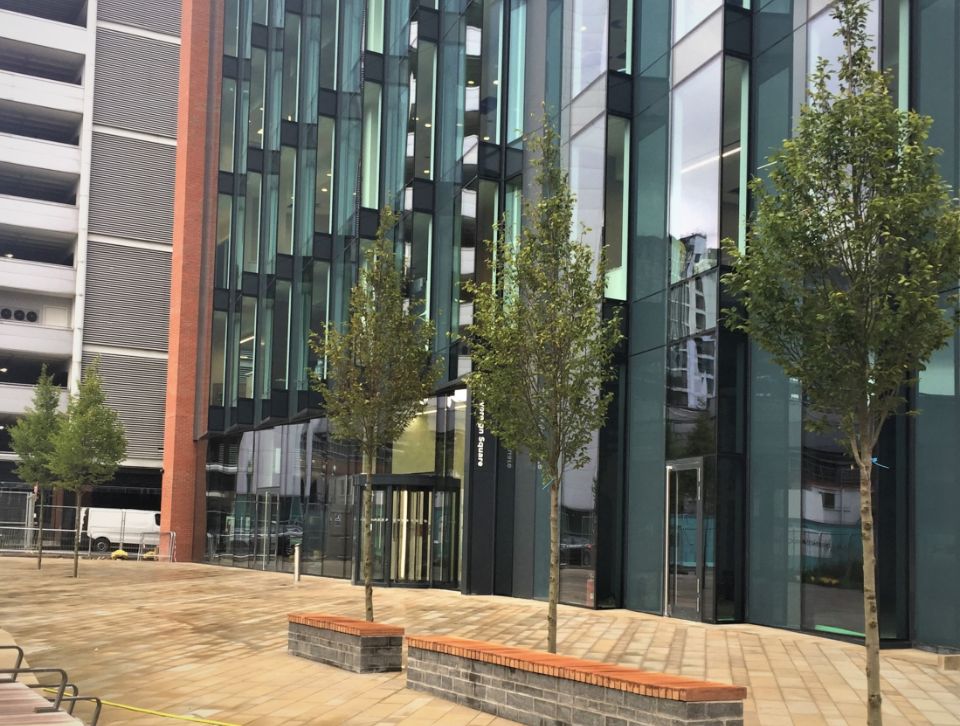
– Silva Cell brings unequivocal results, essential support, and B3 requirements to a 5 acre Catholic Charities campus.
– Two projects help nourish the St. Paul community with dozens of trees.
On the surface, it wouldn’t appear that Silva Cells have much in common with Catholic Charities of St. Paul and Minneapolis. But a closer look reveals how they both are metaphorically and literally supportive of their communities and resilient. Catholic Charities’ Outreach campus, which has grown to 5 acres in Minnesota’s capital city of St. Paul, was expanded with two projects between 2016 and 2018, Higher Grounds St. Paul and Dorothy Day Place. The first project, Higher Grounds, was designed to provide affordable permanent housing and services to pave a pathway out of poverty and homelessness. The landscape and design focused on improving the mental health and well-being of those staying there, by serving as a source of space and outdoor gathering and overflow space, ensuring support for the city’s homeless community shelter to support the city’s homeless community. The extension and design created a series of outdoor “rooms” around the courtyard using trees and paving. Sheltered by the building, the courtyard encourages interaction within the site while also providing a measure of privacy for the residents.
Coen+Partners was the landscape architect, and Margolis was the contractor on both projects which had to comply with Minnesota’s B3 soil volume guidelines. However, the projects differ in soil volume amount and type. Higher Ground used a combination of structural/CU Soil™ and Silva Cells (side by side with an open planter), while Dorothy Day used just Silva Cell. Dorothy Day’s contractor took lessons from the first project, Higher Grounds, saw the benefits of Silva Cell and pursued a Silva Cell only project. In total, 216 3X Silva Cells were installed at Higher Ground and 402 1X Silva Cells were installed across the street on Dorothy Day and on 9th Street.


The trees at Higher Grounds are planted in three different mediums, Silva Cells, open planters and CU Soil as shown in the photo below. The trees to the far left near the tables, are planted with Silva Cell. The trees in the center of the photo, between the concrete walls are in an open planter. The trees to the right in the sidewalk used CU Structural soil.
In comparison, the open-planter trees and the Silva Cell trees are very similar in size, color, and growth, while the structural soil trees are lagging behind, showing signs of maturity already but with limited canopy, adventitious shooting, and slower growth. While these observations are not empirical, they closely match the data from recent research completed by Dr. E. Thomas Smiley at the Bartlett Lab in Charlotte, North Carolina The implications of Smiley’s research and case studies such as this one show that municipal foresters and landscape architects must rely on high-quality soils to achieve their city’s canopy coverage goals. Relying on soil volume standards alone is not enough. Soil quality must be mandated as well. In an effort to reduce excavation depth and the amount of structural soil, Silva Cells were the clear, more cost-effective answer.
Project two, Dorothy Day Place, across the street from Higher Grounds, began shortly after project one finished, in 2018 (see photo below). The street between the projects and the project itself were both named in honor of Dorothy Day (1897–1980), an American journalist and social activist who founded the Catholic Worker movement. She campaigned in defense of the poor, hungry, and homeless. The campus extension turned a parking lot into a shelter and facilitated continuing efforts to support the homeless community Dorothy Day fought for.

A completed Higher Ground and excavation across the street of what will be Dorothy Day.
Both projects met Minnesota’s B3 Guidelines for soil management (necessary as they were greater than 3,000 sf) by using Silva Cells. Soil volumes for the trees varied within in project. At Dorothy Day the trees ranged from 300-550 cubic feet of soil per tree, while at Higher Grounds the soil volume ranged from 700-900 cubic feet per tree. Within the B3 guidelines, structural soil requires 5x the amount of soil volume to meet requirements than that of “nonstructural” soil. Silva Cells were cost-effective and proved to be more efficient in meeting the guidelines than structural soil

Dorothy Day Place as a parking lot in 2017

Dorothy Day Place as a community center, with trees supported by Silva Cell in 2019.
When you give ample support to those that need it, you provide them with a real shot at a healthier life. Whether it is the trees at Dorothy Day Place and Higher Ground St. Paul or the people at the new Catholic Charities Outreach campus, both need a supportive environment to reach higher and live healthier, longer, and more resilient lives.
“Coen+Partners seeks to create equity within the design of the public realm and are committed to the regeneration and the longevity of trees. These were complicated sites with the shallow bedrock and stormwater requirements, and the Silva Cell team was dedicated to helping both Coen+Partners and the contractors to ensure everything fit together and went smoothly.”
– Nate Evans
Dorothy Day and Higher Ground St. Paul in September 2020



Installation Summary:
Number of Silva Cells: Dorothy Day: 450 1x systems,
Higher Grounds: 216 3X systems
Amount of Soil volume total: Dorothy Day: 5,850ft3,
Higher Ground:8,772 ft3
Amount of Root Barrier: Dorothy Day: 120 panels UB 12-2
Higher Ground: 130 panels UB 18-2
Number of trees: Dorothy Day: 12, Higher Grounds: 16
Type of Project: Institutional
Project Designer: Coen+Partners
Project Contractor: Margolis
Project timeline: Higher Ground St. Paul: 2016
Dorothy Day Place: 2018-2020
